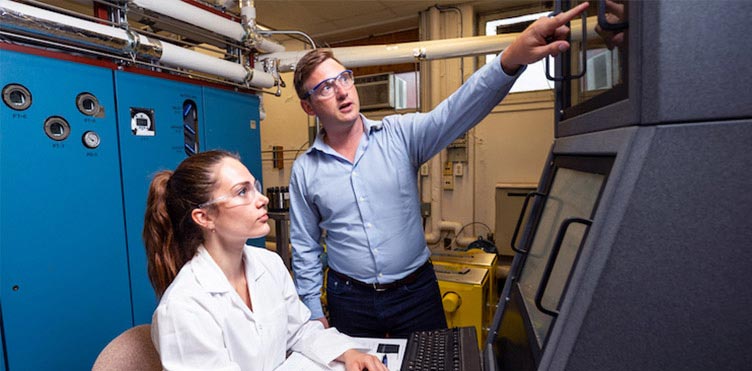
“Nuclear is poised to be a major part of North America’s energy future,” says Dr. Willy Cook (BScE’97, MScCHE’99, PhD’05), a professor of chemical engineering and director of the Centre for Nuclear Energy Research (CNER) at UNB.
“For years, leading climate scientists have been telling us that to rapidly decarbonize and halt a two-degree global temperature rise; that we need to aggressively ramp up both renewables and carbon-free nuclear in the power grids of the world’s major energy producers.”
Because of this, says Dr. Cook, countries with northern climates like Canada, with advanced or growing industrial power needs, or those investing in high-efficiency district heating and electricity infrastructure, are looking to small modular reactors (SMRs) to back-up their variable renewable energy supplies.
SMRs are smaller than conventional nuclear fission reactors, manufactured at plants and assembled on-site. They allow for less on-site construction in addition to increased construction efficiency and shorter timelines. Nuclear power plants are the only non-carbon emitting power plants capable of providing the production capacity required to maintain the grid and balance the intermittent loads of the renewables.
“SMRs may complement or replace current infrastructure,” says Dr. Cook. “Communities in the far North and remote locations are engaging with us since SMRs could replace their reliance on diesel-fired generators while providing significant opportunity for district heating. Heavy industry could benefit from SMR deployment for process heating that currently requires combustion of natural gas or heavy oil.”
UNB has had a dedicated nuclear research centre since 1992, working with both industry and academic institutions around the world on applied research projects that are then implemented in the field. Along with graduate students, full-time chemists, engineers and instrumentation and controls experts, UNB-CNER has established research and development facilities with fully automated test loops that simulate the heat transport systems of nuclear reactors.
In March 2020, UNB signed a letter of intent with Bangor University in Wales to work together on the development of SMRs. CNER also has integrated ties with other Canadian universities who are actively involved in nuclear research and teaching.
“New Brunswick has long been a contributor to Canada’s nuclear supply chain,” says Dr. Cook. “We have a well-established supply chain for nuclear components and a well-educated, well-trained work force at the Point Lepreau Nuclear Generating Station. Point Lepreau is ideal for integration of SMRs to feed New Brunswick’s energy needs with potential for export to the US market.”
Listen: Dr. Willy Cook on why nuclear power is vital in fighting the climate crisis.
Both the federal and provincial governments have recognized New Brunswick’s importance in a carbon-free power market. In 2018, New Brunswick committed $10 million to create an R&D cluster for SMR development. Two leading SMR developers — Moltex Energy and ARC Clean Energy Canada Inc – established offices in Saint John and each contributed an additional $5 million to the research cluster. The University of New Brunswick is participating in the cluster as a centre for advanced nuclear engineering research and teaching.
In 2019, UNB-CNER received $2 million for R&D activities and teaching from the New Brunswick SMR R&D Cluster, which included $500,000 each from Moltex Energy and ARC Clean Energy Canada Inc. The contribution forms the basis of the collaborations initiated with these leading SMR companies and championed by the Government of New Brunswick in the summer of 2018.
In recent decades, international research and development efforts and private companies have produced SMR designs that are inherently safe to operate and propose to re-use legacy fuel from the current generation of reactors to power them, reducing the need for thousands of years of nuclear waste storage to hundreds.
“Many of us equate nuclear power with large capital costs, licensing and engineering challenges, long lead times, cost overruns and the legacy of used fuel that remains radioactive long into the future,” says Dr. Cook. “But SMRs are not the reactors we grew up with. It’s those very drawbacks that SMR developers are making great strides in addressing.”
“The fight against climate change represents the biggest economic and social challenge of our times. But it could also represent one of our biggest economic opportunities,” says Dr. Cook. “We need to adapt and accept the growing place of nuclear energy in a carbon-free world. It’s time for Canada’s nuclear industry to get the attention it deserves if we’re serious about climate change and economic development.”